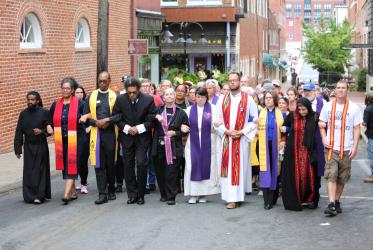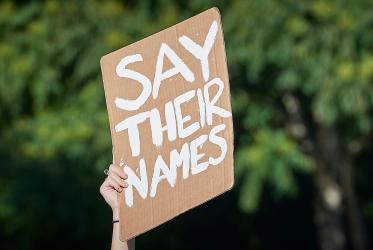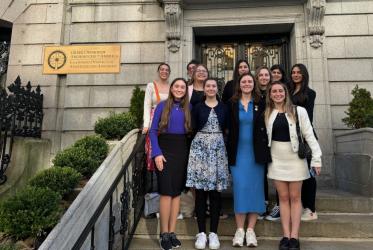Rev. Dr Sharon Watkins was the coordinator of “A.C.T. (Awaken, Confront, Transform) Now,” a series of events on 3-5 April that included an ecumenical gathering; rally in Washington, D.C.; and “National Day of Advocacy and Action.” The three-day event marked the beginning of a Truth and Racial Justice Initiative by the National Council of the Churches of Christ in the USA. As A.C.T. Now came to a close on 5 April, Dr Watkins spoke about the work ahead to eradicate the entrenched racism that grips the United States and paralyzes our ability to see every human being as equal.
Dr Watkins, a former general minister and president of the Christian Church (Disciples of Christ), also serves on the World Council of Churches (WCC) Central Committee.
Q: The A.C.T Now rally marked a milestone in history for churches in the USA. This has been an era of historical rallies in the nation. In what ways does A.C.T. Now intersect with rallies for justice in other areas, and in what ways does it differ?
Dr Watkins: This is a time of awakening in the United States, and of course “Awaken” is a big part of our theme. There is still a lot of work to do for us to be who we claim to be and want to be. I think the Women’s March and, more recently, March for Our Lives were propelled by events of the moment and by as-yet unleashed passion within the population. The A.C.T. Now rally was a planned delving into a deep, deep wound in our psyche, our soul, and our spirit that needs opening to the light and the air in order for there to be healing. All of it comes from a deep longing for wanting to be the best we can be: a people who have been raised and nurtured in a nation that claims the values of freedom, justice and happiness for all. Each one of these rallies is becoming part of a wave, a current of intention to do good in the world.
Q: How important is attention from the media for the Truth and Racial Justice Initiative?
Dr Watkins: We can speak out but if there isn’t the microphone of the press it won’t go very far. With the rally, the fact that the media heard it and then spoke of it is something that we have sometimes felt was missing for our voices, our particular voice of faith, so we were happy with that.
Q: How do we balance looking back at history and acknowledging our mistakes while, at the same time, focusing on a future of hope for ending racism?
Dr Watkins: We do know we can’t solve something we don’t name and claim. It does mean we have to look at the really difficult and even awful parts of not just our past but our present. We have the strength to do that, to look at the difficult truth. Because it’s worth it for the benefit of healing and reconciliation. I always think of the African bird, the sankofa, where the head looks backward and acknowledges the past even as the feet are turned forward.
Q: What is the difference when we talk about ending a system of racism versus feelings of racism?
Dr Watkins: Just recently there was a study released that showed black children and white children who grow up on the same block in the same schools yet still have the same disparate possibilities of where they are in life. The white children still end up going further in life, statistically. The barriers are in place for black children. Yet the white children will think of the black children as their classmates, as their friends. They will feel warmly toward them. They won’t necessarily have any feelings of racism. But it shows the barriers that make it harder for children of color to succeed are systemically embedded. So there is a definite difference between feelings versus structures and systems.
Q: Can you give us an example of a “symptom of racism” that people may not consider or even notice?
Dr Watkins: One very telling example is the difference between how white children and black children are prepared by their parents for encounters with the police. White parents tell white children: “If you’re ever in trouble, look for a police officer.” But for people of color, the police are not historically predisposed to be friendly. A parent might tell a child of color: “Keep your hands on the wheel. Don’t do anything that might be construed as threatening.” To me, that’s a pretty strong example. White people don’t understand this is how privilege works, that we can go into a store and not be scrutinized, that we can walk down the street without people behaving as though we are a threat to them. White people don’t always acknowledge the privilege of having doors open and barriers falling way. We think we are doing it all by ourselves.
Q: How has the World Council of Churches been in solidarity with churches in the USA in the fight against racism?
Dr Watkins: The way the WCC came to the US on a solidarity visit two years ago was the catalyst that spurred us to action. And the WCC and international churches can continue to offer solidarity to us in our journey.
I would add also that racism is not just a US problem, it’s a global problem. The WCC and international churches also need to look into their own complicity in an internationally racist system, in the colonialist structure of the world. While Americans have a very deep structure around this, the global economic system is also intertwined. The whole development of whiteness as a social construct has long been part of the global economic structure. We are inter-dependent, so racism must be grappled with internationally as well.
Learn more about the “Act Now to End Racism” event and initiative
"Dear white Christians: what now?" (WCC news release 5 April 2018)
Read WCC moderator Dr Agnes Abuom’s remarks to the ecumenical gathering
Read a first-person account of the 1968 WCC assembly and the Programme to Combat Racism






